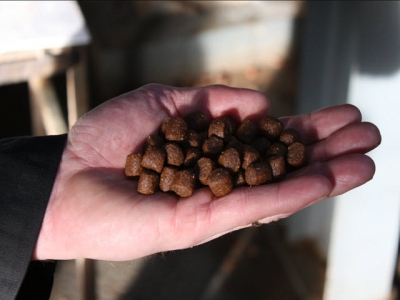Whats salmon feed really made of?

A new report shows that between 2012 and 2016 an increasing amount of terrestrial raw materials are used in salmon feeds.
In 2016 a total of 1.62 million tonnes of raw feed materials were used to produce 1.26 million tonnes of salmon in Norway
Currently 75 percent of the content of Norwegian salmon feed is derived from the land, compared to 70 percent in 2012. Soya protein concentrate, which is protein isolated from soya beans, used to be the largest individual ingredient and was responsible for 19 percent of feed in 2016. At the same time the use of soya in feed has dropped slightly since 2012 in favour of several other sources of plant-based protein, such as wheat, maize and broad beans. Marine sources of protein accounted for a total of 14.5 percent of feed ingredients and marine oils for 10.4 percent.
These figures are presented in a Nofima report entitled “Resource Utilisation in Norwegian Salmon Farming in 2016”, which contains updated figures derived from similar reports produced in 2012 and 2010 using data reported by industrial feed producers and fish farms. In 2016 a total of 1.62 million tonnes of raw feed materials were used to produce 1.26 million tonnes of salmon in Norway.
“The main trend seen in these figures is that the use of fishmeal is continuing to drop,” says the project manager, Turid Synnøve Aas.
The composition of Norwegian salmon feed has changed considerably over the last few decades, from being primarily based on fish meal and fish oil to containing a substantial percentage of plant-based ingredients.
Most of the marine ingredients were of North Atlantic origin and were approved under primarily sustainable certification schemes.
The traceability and certification schemes which apply to plant-based raw materials are not as well developed as those which apply to marine-based raw materials. Consequently, a lower percentage of the plant-based raw materials used in 2016 were certified, standardised or had unknown origins.
“As far as we know, Norwegian fish farming is the only national food production system which uses animal protein where data is available throughout the year in respect of feed production and food production for the whole industry in one country. This data, which has been provided by feed suppliers on the Norwegian market and fish farmers, etc, means that it is possible for us to calculate the full effectiveness of overall production,” says Dr Aas.
Related news
Tools

Phối trộn thức ăn chăn nuôi

Pha dung dịch thủy canh

Định mức cho tôm ăn

Phối trộn phân bón NPK

Xác định tỷ lệ tôm sống

Chuyển đổi đơn vị phân bón

Xác định công suất sục khí

Chuyển đổi đơn vị tôm

Tính diện tích nhà kính

Tính thể tích ao



 The stage is set to solve the riddle…
The stage is set to solve the riddle…  Propolis extract may boost Nile tilapia survival in…
Propolis extract may boost Nile tilapia survival in…